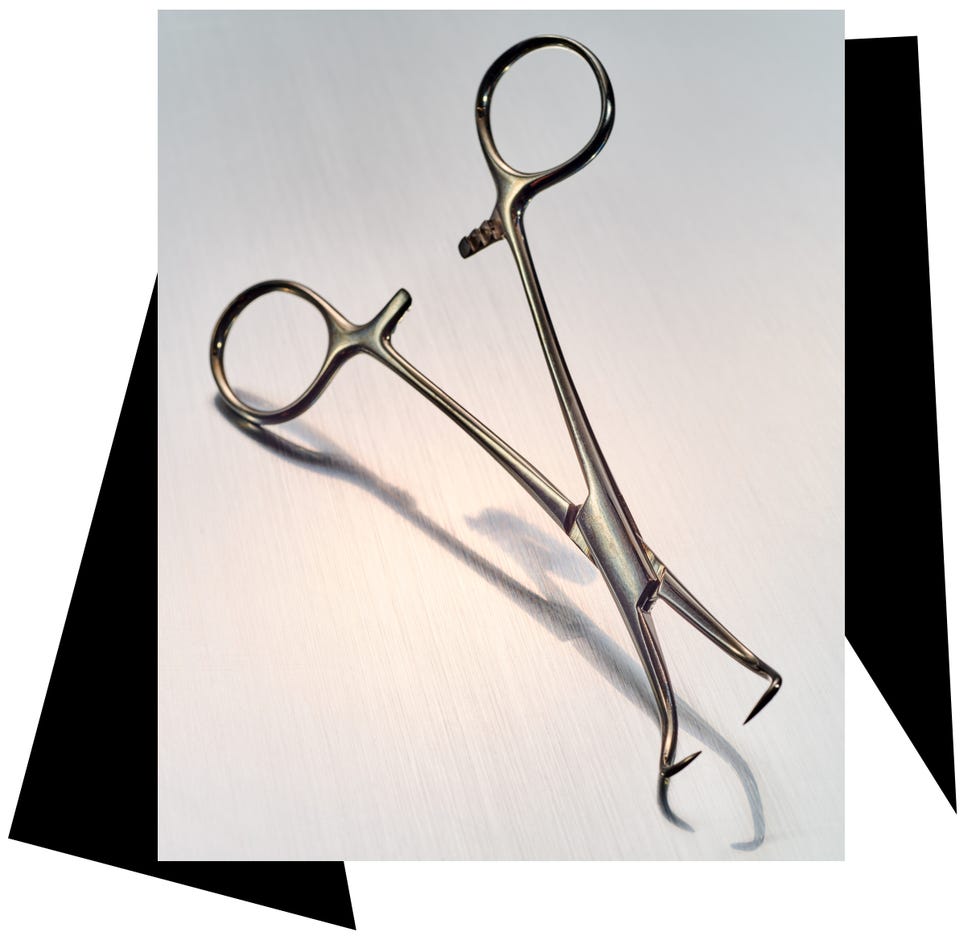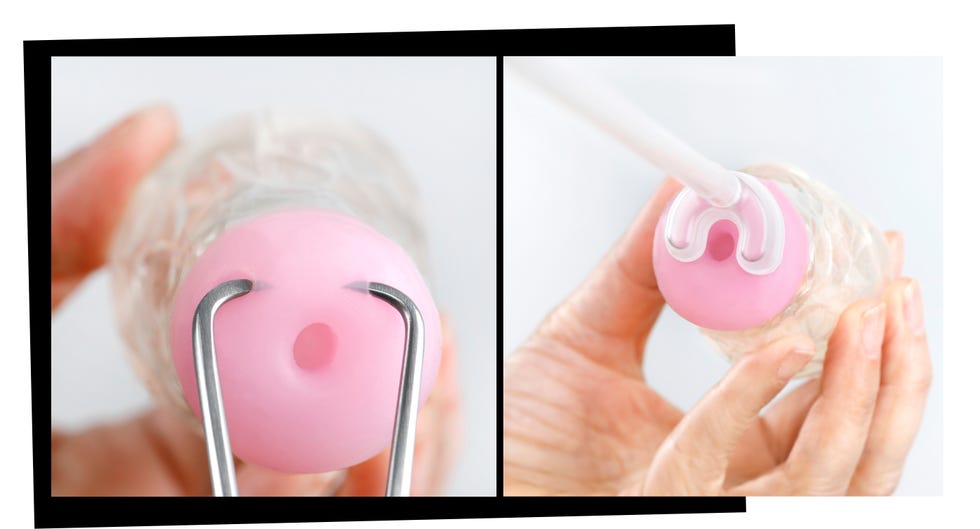If you ask a group of women if they’ve ever had an IUD placed, their responses about the experience will likely vary. Some may shrug and say, “It wasn’t too bad” or “It was like a really bad period cramp.” But chances are high that at least one will have a horror story.
They fainted from the pain. Or maybe threw up. Or screamed out loud. Maybe the doctor had to try three or four times to place the device, and the bleeding wouldn’t stop. They might tell you it was the worst thing they’ve ever endured, even worse than childbirth, and that they still have trauma from it.
As of 2023, roughly one in five women of reproductive age have had an IUD, a threefold increase from 2007 to 2010. And as the birth control method becomes more popular with younger women who haven’t given birth, its pain profile seems to be increasing. About half of the women in a recent study on IUD placement and pain reported “intense” pain at placement, and another 47 percent reported light or moderate pain. Only 2.5 percent reported no pain. The pain scores were highest among women who had not given birth.
This is not a new phenomenon—studies going back to the 1970s and ’80s have tried to understand and solve IUD insertion pain. Even though the experience can vary vastly, women have been saying for a long time that it can be really, really painful. But it felt like no one was taking them seriously—or doing anything about it—until recently.
Behind the scenes, some experts have been working on this issue, and in the past year, there’s been a groundswell of positive change that will directly impact what’s going on in doctors’ offices. In 2023, the Swiss start-up Aspivix received FDA approval for a new IUD insertion tool, the Carevix (whose name comes from the idea that the company is “caring” for your “cervix”). Early patient trials in Europe showed up to 73 percent less pain and up to 83 percent less bleeding. Then, in August of this year, the CDC updated its guidelines for IUD insertion, highlighting the need for doctors to discuss and offer pain management options for their patients. While the CDC has always provided guidance around mitigating pain, the new guidance gives providers a roadmap for how to talk to patients, involve them in the decision process, and take a patient-centered approach, says Alison Edelman, MD, MPH, an ob-gyn specializing in complex family planning and a professor of obstetrics and gynecology at Oregon Health & Science University.
“There has been this shift, especially over the last five to 10 years, of centering patients’ experiences, needs, and preferences more than before,” adds Katharine White, MD, chief of obstetrics and gynecology at Boston Medical Center. By that, she means listening to what patients want and listening to their concerns—whether that’s taking their pain more seriously, offering different pain management options, or simply not pushing one type of birth control or procedure on them. “It is long overdue, but I think we are finally going in the right direction…. We have reached a tipping point, and I could not be happier.”
The CDC guidance not only establishes a standard of care, but it also gives patients the tools to ask for what they need—whether that’s stronger pain meds or a quick breather during a painful procedure. And the Carevix’s arrival signals innovation in a field that is often very slow to change. Things are starting to look up.
Caring For Your Cervix
Dr. White used to collect old medical instruments on eBay, and she was shocked by how little gynecological tools have changed since their inception. Take the tenaculum, the surgical tool resembling long metal scissors with two hooks at the ends, which was inspired by medical implements used during the Civil War. Early versions were used to extract bullets from wounds, and slightly updated versions have been used in gynecology practices for at least a century. In the words of Dr. Edelman, it simply “looks like a torture device.”
It’s not just the tenaculum that is ancient history—speculums haven’t had a major update since 1878, and IUDs haven’t changed shape since the 1960s, when the first breast implants were created.
That’s where the Carevix comes in. Aspivix, founded in 2015, created the first prototype in 2019; it used a half-moon-shaped suction device to grasp the cervix, instead of puncturing or clamping down on the tissue the way a tenaculum does. The pandemic slowed the initial rollout, but earlier this year, Aspivix secured a distribution deal with pharma giant Bayer, one of the global leaders in IUD production. There are also 25 ambassador-program sites across the world, including private clinics and doctors’ offices, where the tool is being used, as well as universities that are testing it. So far, 860 patients have had procedures done with the Carevix through these sites.
After an incredibly painful and traumatic IUD insertion in 2017, which involved a medical tool getting stuck on her labial tissue, 30-year-old Taylor Townsell was desperate for something—anything—that could ease the pain she anticipated for her 2023 insertion. She did some research online but came up empty and found herself in tears. When Townsell finally stumbled upon the Carevix, she filled out a form on Aspivix’s website asking for help. “I sent them the saddest, most impassioned email request. And it was basically just like, ‘I have to get an IUD again. I don’t know if I can handle it. Please help me. Is there anyone in the U.S. that is authorized to use this?’” Townsell says. She got a quick reply from senior manager of global operations Eric Lluvich, who checked in on her and helped her get connected with providers at Columbia, where the Carevix was being used.
Soon, with five people in the room—Townsell, her boyfriend, a patient-care advocate, the supervising doctor, and a doctor in training—the doctor used the Carevix to place her copper IUD. “It felt like someone was just, like, lightly holding me. It wasn’t the pinch of the tenaculum,” she says of the sensation from the suction. “I think it minimized the pain so much to the point where I don’t think I would be as nervous the next time, but I would need to have the Carevix there.”
Townsell highly recommends the tool after the experience and says she hopes more people hear about it and can have it used during their own procedures.
Alissa Conklin, MD, an assistant professor of obstetrics and gynecology at Indiana University, is running the first U.S. pilot study on the Carevix. So far, results from a very small patient sample haven’t shown statistically significant differences in pain during IUD placement with the Carevix versus the tenaculum, but larger studies will hopefully be able to show a stronger correlation between use of the device and pain reduction, Dr. Conklin says. Another good sign was that providers perceived that their patients were in less pain when the Carevix was used.
The upside is that these early results gave researchers enough information to know they should expand the trials, says Dr. Conklin. Currently, a multi-center study is in the discussion stage.
“I haven’t touched the instrument or seen it in action, so I can’t speak to it directly, but what I could say is I am so overwhelmingly thrilled that this space, which has gone untouched for so long, is finally getting attention,” says Dr. White. “Studies in humans will be really critical before we think about making wide-scale changes in practice. But we’ll never get anything better if we don’t try.”
Aaron Lazorwitz, MD, an ob-gyn specializing in complex family planning at Yale School of Medicine, also hasn’t personally used the Carevix or seen any of the company’s data on the tool (partly because it’s still being studied), but he similarly feels optimistic that steps are being taken to push his field forward. “This is old equipment that we’ve been using for a long time. So any innovation, any new technology, I’m a huge fan of, because it’s just got the potential to make things better,” he says.
And while Dr. Edelman isn’t sure if the Carevix is the be-all, end-all answer to IUD pain, she is certain it’s a harbinger of change. “Sometimes those [innovations] don’t end up being things that work for everybody for every situation, but if we don’t innovate and try, then we never get to a better place, right?”
Questions That Still Need Answers
Even as doctors and companies try to innovate, solving IUD insertion pain completely remains a bit of a conundrum. That’s partly because the experience can be so variable.
“I’ve put IUDs in patients who were 13-year-olds who’ve never had anything in their vagina ever, and they were like, ‘Oh, you’re done already?’ And I’ve put IUDs in patients who’ve had four kids without an epidural, and they’re like, ‘That was worse than childbirth,’” says Dr. Conklin.
Women also have different pain responses during different parts of the insertion process. For some, the worst is the speculum insertion. For others, it’s the tenaculum biting down on their cervix. But most find the actual device insertion the most painful. So upgrading one tool is not a silver bullet that will suddenly fix the entire process. But the Carevix is still an important development, as replacing the tenaculum is a “critical part” of addressing IUD insertion pain and discomfort, says Susan Nicholson, MD, Aspivix’s board chairwoman and scientific advisor.
Currently there are three pain management options for IUD insertion or removal: oral or injectable medications, lidocaine (an analgesic), and sedation. Most providers have been using oral pain meds for years, but those really only work for cramping pain, says Dr. White. In fact, “most [pain] medications have been shown to not work” on the actual pain caused by insertion, Dr. White adds.
Sophie Lovett, a 28-year-old American attending graduate school in Rome, has had three IUD insertions with vastly different experiences each time. The first go-round, when she had a nonhormonal Paragard placed, she took an oral pain pill and anti-anxiety medication before the insertion. It went smoothly, and she didn’t have any major pain. For her second IUD, Lovett went to a different doctor, who convinced her to try a smaller, hormonal IUD, even though her Paragard had worked well. This procedure didn’t go so well.
“I was not prescribed anything, and the insertion process was horrendous,” Lovett says. It took the doctors three or four tries to insert the device, and they had to use an ultrasound to help with placement—an additional cost Lovett was not expecting or consulted about. “It was the worst experience, not only financially but also just the pain of it,” she says.
At the appointment, Lovett felt like the doctors were laser-focused on getting the IUD placed no matter what and didn’t really check in with her or seem to care that their continued attempts to place the device were hurting her. “I didn’t feel like I was being treated like this human who felt pain,” she says. “I definitely felt taken advantage of and just sort of not cared for.”
After finally deciding she didn’t like how the hormonal IUD made her feel, Lovett chose to go back to the Paragard and visited a third doctor where she was living in Los Angeles at the time. This doctor prescribed an anti-anxiety medication and a topical internal numbing cream for her cervix (?) that Lovett could apply herself before the procedure. Though it wasn’t completely pain-free, it was the best experience of the three, she says, and she still has the same IUD to this day.
“She just really cared for me as a person,” Lovett says of the L.A. doctor. And it wasn’t just the pain management counseling that made a difference. The general environment of the office—the furniture, the lighting, the temperature—made Lovett feel comfortable too.
Before placing an IUD, Dr. Lazorwitz talks his patients through various pain management options. But it’s not a perfect formula. “There is no one-size-fits-all ‘this will make the pain go away,’” he says. “You never really know for each patient. Some parts are more painful than others and you kind of just have to talk through it as you go.”
That’s why it’s important for doctors, who are not always the best assessors of patient pain (some patients are stoic while others are more vocal about the same level of pain), to empower their patients to say “stop” at any time, says Dr. Edelman. There’s no pass or fail in IUD placement, she adds, recalling a recent clinic patient who was very focused on getting her device placed that day. In response, Dr. Edelman told her: “That may be your priority, but you haven’t experienced it yet, and we may get to a point where you’re like, ‘I made the wrong choice for myself.’ And so [it’s] okay to say stop.”
Barriers To Entry
Just because pain management options exist doesn’t mean they’re always accessible. For starters, not all doctors’ offices can provide lidocaine injections or sedation, which often requires a separate anesthesia setup, says Dr. White. In fact, only 4 percent of doctors in the U.S. offered local anesthesia injections for IUD insertions, per a recent survey cited in The New York Times.
Even if you do have access to prescription medication or anesthesia, your insurance may not cover it. Dr. Conklin says that insurance reimbursement for pain management is “horrible.” To that end, she wants the CDC to follow up its new guidelines by requiring insurers to cover the options the agency recommends that doctors use, like lidocaine injections. She also points out that there is a “humongous discrepancy in reimbursement for what is done for a female patient versus a male patient with the exact same procedure.” Take a vulva biopsy and a scrotum biopsy, two procedures involving equivalent anatomy and tools. “That male biopsy is reimbursed four times the amount of what is reimbursed for the female biopsy using the exact same instruments. It’s insanity,” she adds.
Sometimes the pain itself becomes a barrier to entry for someone seeking long-term birth control, with women opting for other methods simply because they don’t want to endure the painful procedure. Whether they’ve heard frightening stories from friends and sisters or had a bad insertion experience themselves, the thought of the discomfort that lies in store can be enough to make women stop in their tracks.
Jenna Smith, a 35-year-old former schoolteacher now in sales, has had two IUDs placed and removed without significant pain. In fact, the worst part was the speculum insertion and the anxiety that preceded it. Her first two insertions and first removal went off without a hitch, but by the time she was ready for her second removal, she had started to hear scary stories from friends.
“I was so anxious about it, because I’ve heard friends with horrible experiences [talk] about it, and I was just like super in my head,” she says.
Luckily, Smith decided to speak up about her anxieties before the appointment. She was traveling, so she met with a nurse practitioner at a university hospital. “I let them know, ‘Hey, I’m super anxious about this. I don’t know why. I’ve had it done before. It didn’t hurt me before, but for whatever reason, I’m super, super anxious.’ They were amazing. They talked to me through everything,” she says.
After sharing her fears and worries, the nurse practitioner made Smith feel comfortable every step of the way. And it made a world of difference.
Revolutionary Ideas
The fact remains that women’s pain—and specifically gynecological pain—is often discounted. And while we’ve been talking about this for decades, progress is still slow. In a recent U.K. survey of more than 4,000 women with endometriosis, 70 percent had to visit their doctor at least five times—with 47 percent having to go 10 times or more—to get an official diagnosis.
“For a long time, women’s pain has been downplayed and disregarded,” says Dr. White. “My kids use the word gaslight like candy. They use it all the time. But this is actually an area where I think talking about gaslighting may be appropriate.”
While the Carevix aims to solve one part of the pain problem, several others remain: the actual insertion of the device through the cervix opening, plus the crampy pain that can continue if the IUD’s shape doesn’t match the shape of the endometrial cavity or uterus. Innovation at these literal pain points is necessary too.
Luckily, there are several companies and researchers out there putting their money and brainpower to work in order to solve these big questions.
Dr. Lazorwitz sits on the scientific advisory board of a company called 3Daughters that is working on a new frameless, magnetic, nonhormonal IUD resembling three little beans, which self-assemble in the uterus. These “beans” have their own special applicator and don’t require a tenaculum—solving two issues at once. The device is not yet commercially available, but the company planned to start phase-one trials this year.
Contrel Europe, a biotech company in Belgium, is also hoping to innovate IUD shape by creating a frameless IUD called the GyneFix that is one-third the size of existing products. Its IUD is made of small copper tubes linked to a surgical thread that is implanted in the top of the uterus.
And over at Western University in Ontario, Samantha Gateman, PhD, an assistant professor of chemistry and a researcher studying corrosion, was inspired by her own birth-control experience to develop a nonhormonal IUD that uses a different material—iron instead of copper. Right now, her team is focused on tailoring the corrosion rate of the metal for effective use in an IUD (the metal is what gives the IUD its pregnancy-prevention powers), but once that research is complete, they could prototype a new IUD shape with the upgraded material. Still, it might be about 10 years before a new product hits the market.
Doctors are dreaming up their own innovations too. “What if you could just put a little bit of liquid in the uterus and then it just formed into your IUD?” asks Dr. Edelman. “Wouldn’t that be great? You wouldn’t have to put any instruments in. You could just get it in the right place, have it go up, have it kind of solidify in place, and then you’d be all set to go.”
No matter what future developments look like, women’s comfort will be at the heart of these innovations. And that’s long overdue.
“I hope that they get less painful for people in the future. I hope that there are things that people are working on to make it less painful, whether that’s medication or the actual device itself,” says Lovett. “But in the grand scheme of things, it’s [the Paragard IUD] been such a good solution for me.”
What To Do:
Know your options.
If you’re heading into an IUD consultation, arm yourself with information and questions for your provider so that you feel mentally and physically prepared. Simply getting your doctor to walk you through the procedure and pain management options can make a real difference. “What also helps relieve pain is knowledge and feeling like you get to make choices and have control over a situation,” says Dr. White.
Curate a peaceful environment.
As Lovett demonstrated, there are also things unrelated to medication that can make a big difference in your experience. Some doctors’ offices might provide things like music, aromatherapy, or the ability to bring a support person with you, says Dr. White.
Speak up.
If something isn’t working for you, you don’t have to grin and bear it, says Dr. Edelman. It’s important to speak up and tell your provider what you want and what you’re experiencing. And they should listen.
“Advocate for yourself,”adds Lovett. “Ask questions, talk about it, follow your gut. No one knows your body like you do.”
Photographed by Joe Lingeman. Styling by Mia Katoh.
Currie Engel is the news and features editor at Women’s Health. She loves working on zeitgeisty news, culture, mental health, and reproductive rights stories. When she’s not editing stories, she’s writing them. Currie previously worked as an award-winning local reporter specializing in health investigations and features, and as a researcher at Time magazine.










